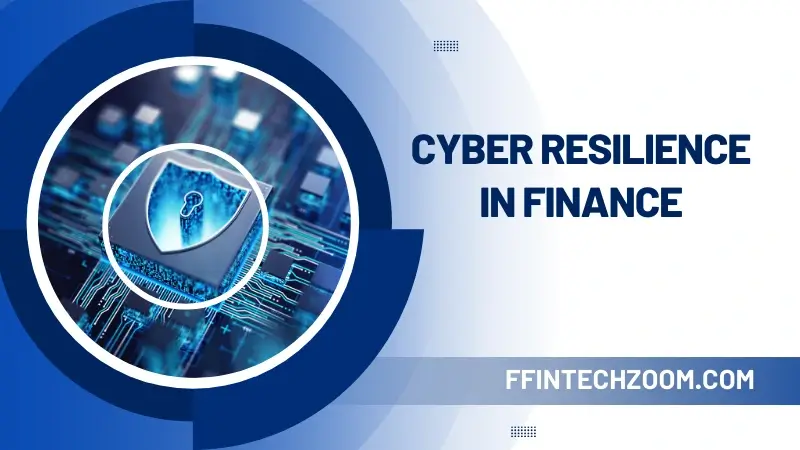Cyber Resilience in Finance: The Key to Future-Proofing Digital Economies
The financial industry is rapidly evolving, embracing digital transformation to offer more accessible, efficient, and innovative services. However, as financial services go digital, they also face increasing cybersecurity risks. From data breaches to ransomware attacks, the stakes are high. Cyber resilience has, therefore, become a critical component of the financial sector’s infrastructure. Financial institutions can better prepare for, respond to, and recover from cyber incidents by focusing on resilience, ensuring that their services remain secure and uninterrupted.

This article explores cyber resilience, why it’s essential for financial institutions, and how it contributes to the future-proofing of digital economies. We’ll also examine how integrating threat intelligence can bolster this resilience.
What is Cyber Resilience?
Cyber resilience refers to an organization’s ability to continuously deliver critical services and operations, even in the face of cyber disruptions. It’s about preparing for, responding to, and recovering from cyber-attacks or failures in a way that minimizes downtime and damage. Unlike traditional cybersecurity, which focuses primarily on preventing attacks, cyber resilience emphasizes recovery and adaptability.
In a sensitive sector like finance, where a single breach can cause significant financial loss and reputational damage, a robust cyber resilience strategy is indispensable. Financial institutions need to be equipped not just to defend against cyber threats but also to recover swiftly if a breach or failure occurs. We have also covered Financial Planning for Senior Living on our website.
The Importance of Cyber Resilience in the Financial Sector
Protection of Sensitive Data
Financial institutions manage vast amounts of sensitive customer data, including financial transactions, personal details, and account information. A breach or compromise of this data can have severe implications, ranging from identity theft to large-scale fraud. Cyber resilience ensures that systems are in place even if such data is exposed or stolen to mitigate the damage and quickly restore services.
Minimizing Downtime
In today’s digital world, downtime can be costly for any business, but the stakes are even higher for financial services. Whether it’s an online banking platform, a payment gateway, or a stock trading system, customers expect seamless, 24/7 access. Any service disruption can result in lost transactions, missed investment opportunities, and dissatisfied customers. Cyber resilience ensures that systems can recover quickly, minimizing service interruptions and helping to maintain customer trust. Find valuable tips and strategies in our article about Working with an Online Mortgage Broker.
Regulatory Compliance
The financial industry is heavily regulated, with strict data protection laws safeguarding customer information. For example, regulations such as GDPR in the European Union and the CCPA in California require financial institutions to take appropriate measures to protect user data. Cyber resilience is not just a best practice but also a compliance necessity. A strong cyber resilience plan helps ensure that financial institutions meet regulatory requirements, even in the event of a cyber incident.
Protecting Reputation and Customer Trust
Reputation is everything in the financial sector. A cyber attack can lead to losing customer trust, which is often hard to rebuild. Even if financial institutions recover swiftly from an attack, the damage to their reputation may persist. By investing in cyber resilience, financial firms can demonstrate to their customers that they have robust systems to protect their data and services, thereby preserving their trust. Enhance your understanding by reading our in-depth post on SEPA Instant Transfers.
The Components of Cyber Resilience in Finance
Cyber resilience is not a one-size-fits-all approach; it requires a combination of proactive, reactive, and adaptive strategies. Below are the key components that contribute to building a resilient cyber environment in the financial sector.
1. Proactive Threat Prevention
Proactive threat prevention involves identifying and addressing potential vulnerabilities before cybercriminals can exploit them. This includes implementing firewalls, encryption protocols, multi-factor authentication, and other security measures to protect against unauthorized access. Regular security assessments, penetration testing, and vulnerability scanning are also essential to identify system weaknesses.
While proactive measures are important, they are not foolproof. The threat landscape constantly evolves, and new types of cyber threats are emerging daily. That’s where the next component of cyber resilience comes in.
2. Cyber Threat Intelligence
Financial institutions must continuously monitor and analyze emerging risks to stay ahead of evolving cyber threats. Cyber threat intelligence services play a crucial role by providing organizations with actionable insights into potential cyber-attacks. By gathering data from various sources, including the dark web and global cyber threat intelligence platforms, institutions can better understand the tactics, techniques, and procedures used by cybercriminals.
This information allows financial institutions to strengthen their defenses and decide which risks to prioritize. By integrating threat intelligence into their cybersecurity frameworks, institutions can ensure they are not only reacting to incidents but proactively defending against them. It helps organizations anticipate threats and quickly implement countermeasures before an attack can cause significant harm.
3. Incident Response and Management
Even the best-prepared financial institutions can fall victim to cyber-attacks. That’s why it’s essential to have an effective incident response plan in place. Incident response involves procedures that organizations follow when a cyber incident occurs. The goal is to contain the attack, minimize damage, and recover quickly.
A good incident response plan includes clear communication protocols, designated response teams, and tools to identify and neutralize threats. Financial institutions should also have a recovery plan to restore normal operations, whether through system backups, cloud-based solutions, or failover systems.
4. Continuous Monitoring and Adaptation
Cyber resilience is an ongoing process. As cyber threats evolve, so must an institution’s ability to withstand them. Continuous monitoring is essential for identifying and responding to potential threats in real-time. Financial institutions should implement advanced monitoring tools to detect abnormal activity and quickly alert the security team.
In addition to monitoring, financial organizations must continuously adapt their cybersecurity measures to address new risks. This involves staying current on the latest trends in cybercrime, investing in new technologies, and updating internal policies and procedures to keep pace with the ever-changing threat landscape.
How Cyber Resilience Contributes to Future-Proofing Digital Economies
Enabling Growth and Innovation
A resilient financial sector can unlock new opportunities for growth and innovation. As more industries transition to digital platforms, the demand for secure financial services will continue to rise. Cyber resilience allows financial institutions to take advantage of this demand by offering new products and services with the confidence that their systems are protected.
For instance, innovations such as digital wallets, blockchain, and cryptocurrencies all require secure infrastructures. Financial institutions prioritizing cyber resilience can build and scale these technologies while maintaining customer trust.
Building a Robust Digital Infrastructure
Cyber resilience also plays a key role in building a robust digital economy. A digitally connected world depends on securing transactions and maintaining trust in financial systems. If customers fear their data is at risk, they may avoid using digital financial services altogether.
Financial institutions investing in cyber resilience ensure that digital economies continue operating smoothly, securely, and efficiently. This helps create a future-proof environment where businesses and consumers can confidently transact.
Conclusion
As the financial sector embraces digital transformation, cyber resilience has become a non-negotiable pillar for ensuring business continuity, data protection, and customer trust. By focusing on proactive threat prevention, effective incident response, and continuous adaptation, financial institutions can ensure they are ready to face emerging cyber threats.
Cyber resilience is not just about minimizing the impact of attacks—it’s about enabling growth, innovation, and the sustainability of digital economies. With the right systems and strategies, financial institutions can successfully navigate the complexities of the digital age and emerge stronger in the face of adversity. You can visit Fintechzoom.com for more trending posts.




